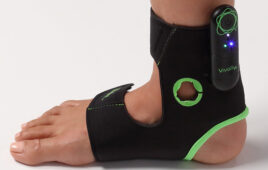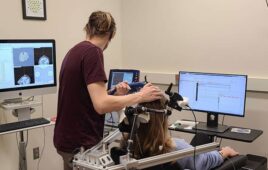Scientists in the United States, Europe and South America are reporting how a new cloud-computing web platform allows scientists to track data and analyses on the brain, potentially reducing delays in discovery.
The project, called brainlife.io, is led by Franco Pestilli, associate professor in the Indiana University Bloomington College of Arts and Sciences’ Department of Psychological and Brain Sciences and a member of the IU Network Science Institute, in collaboration with colleagues across the university. At IU, it is speeding research on disorders such as dementia, sports concussion and eye disease.
A new paper on the project was published May 30 in the journal Scientific Data.
“Scientists are increasingly embracing modern technology to reduce human errors in scientific research practice,” said Pestilli, who established brainlife.io in 2017 with support from the National Science Foundation and Microsoft.
“This article describes a unique mechanism by which scientists across the world can share data and analyses, which allows them to reproduce research results and extend them to new frontiers of human understanding,” he added. “The benefit of such a platform is faster research on brain disease.”
The system manages all aspects of research where people are more likely than machines to make mistakes, such as keeping track of data and code for analyses, storing information, and producing visualizations.
At IU, brainlife.io is being used to advance research on multiple health care research studies. Examples include:
- – Research on sports concussion and chronic traumatic encephalopathy led by Nicholas Port at the IU School of Optometry in Bloomington.
– Research on Alzheimer’s disease led by Andrew Saykin at the IU School of Medicine in Indianapolis.
– Research on macular degeneration in collaboration with researchers in Japan and Europe, which was recently published in the journal Brain Structure and Function.
The new paper provides a “case study” on how to generate a full research study, including data collection, analysis and visualization, on the brainlife.io platform. It also describes how the system preserves data and analyses in a single digital record to create reusable research assets for other scientists to use in their work.
“I like to refer to the new technology as a process of ‘data upcycling,'” Pestilli said. “The new records that scientists create and share on brainlife.io can be easily reused by others to go beyond the goals of the original study.”
For example, a study on traumatic brain injury could potentially combine data from a study on Alzheimer’s disease to understand underlying biological mechanisms in both conditions.
Importantly, Pestilli added, brainlife.io is designed to store and process data derived from diffusion-weighted magnetic resonance imaging — a form of imaging that uses water molecules in the brain to create a highly detailed roadmap of the nerve tracks in the brain — as well as tractography, a 3D modeling technical to visually represent these nerves and understand the network of connections that make up the brain.
“The use these imaging techniques has revolutionized knowledge about networks inside the brain and the impact of the brain’s white matter on human behavior and disease,” Pestilli said. It also generates enormous amounts of data that require serious computer resources to store and analyze.
Some of this computing power comes from Microsoft, which chose brainlife.io as one of the first eight projects to benefit from the company’s initiative to award $3 million in compute credits to projects under the NSF’s Big Data Spokes and Planning projects, of which IU is a part. The project is also supported under the NSF’s BRAIN Initiative, a federal project to generate new physical and conceptual tools to understand the brain.
IU contributors to brainlife.io include Soichi Hayashi, a software engineer at the IU Pervasive Technology Institute; graduate students Brad Caron, Lindsey Kitchell, Brent McPherson and Dan Bullock; and undergraduate students Yiming Qian and Andrew Patterson. Bullock and McPherson were supported by grants from the National Institutes of Health and NSF.
Additional authors on the article include researchers at Indiana University, the University of Michigan at Ann Arbor, Northwestern University, the University of Trento in Italy and CONICET in Argentina.
What they’re saying
“This research shares new methods and platforms that help neuroscientists collaborate across disciplinary boundaries, share data, reproduce results and strengthen neuroscience,” said Kurt Thoroughman, a program officer at the NSF. “Findings like these demonstrate NSF’s commitment to the BRAIN Initiative and efforts to improve our understanding of the neural basis of human cognition. These findings have implications across the brain sciences, including understanding normal brain functions and improving outcomes for the over 1 million Americans with diseases of the brain.”
“This work is groundbreaking because it combines brain data with trackable, referenceable processing assets and powerful command line and visualization tools,” said Vani Mandava, director of data science at Microsoft Research. “Supporting innovative solutions to technical challenges that support new insights and treatments on the brain — like this interface that promotes open data and reproducible science — is part of our data science research mission at Microsoft.”




